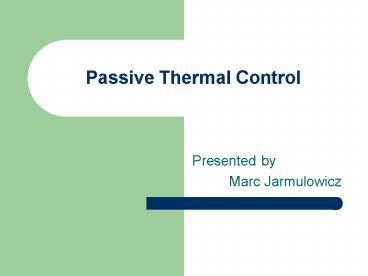Passive Thermal Control - PowerPoint PPT Presentation
1 / 13
Title:
Passive Thermal Control
Description:
No atmosphere or convection to distribute energy. Spacecraft must reflect and ... Reusable Surface Insulation Tiles) with a lower weigh quilt like material ... – PowerPoint PPT presentation
Number of Views:261
Avg rating:3.0/5.0
Title: Passive Thermal Control
1
Passive Thermal Control
- Presented by
- Marc Jarmulowicz
2
What is going on?
- Sun gives off radiation
- No atmosphere or convection to distribute energy
- Spacecraft must reflect and radiate unwanted
energy to maintain temperatures for humans and
electronics
3
Diagram
4
Physics
- Emissivity is the amount a material emits
radiation - A white material will emit very low amounts of
energy, whereas a black material will emit a
great deal of energy - Absorptivity relates to the amount of radiation
that a material will absorb from an energy source - a white material absorbs very little radiation,
while a black material will absorb a great deal
of radiation
5
Temperature requirements
- Satellite components (temperature range)
- Liquid Propellant 44.6 - 95 F
- Batteries 41 - 68
- Electronics 32 - 104
- Structural Elements -47 - 149
- Solar Arrays -146 - 212
- Infrared sensors -326 - -110
6
The solution
- To maintain the internal temperature of a
spacecraft, different levels of active and
passive thermal control systems are used
7
What is PTCS?
- A Passive System
- Low energy use
- Low maintenance
- Low cost
- Low weight
8
Different Missions Different Solutions
- Deep Space Craft
- Extremely low energy
- Orbit may take craft close to Sun as well as Deep
Space - ISS
- High heat generation
- Space Shuttle
- Re-entry heat dissipation
9
Exploration Satellites
- Multi-Layer Insulation
- Made of Aluminized Kapton, Gold plated
- Good at reflecting radiation both from the
environment and back into the craft. - e 0.30 , a 0.023
- Optical Solar Reflectors (OSR)
- Panels used to reflect sunlight and radiate
energy - Made of Quartz tiles
- Louvers
- Bimetallic controlled vanes that expose or
insulate the internals of a spacecraft to space.
10
ISS
- MLI
- Insulates and reflects radiation
- Protects Kevlar from radiation damage
- Surface Coatings
- Changes e and a of any outer skin not protected
by MLI - Does not insulate as well as MLI, but is cheaper
- Heaters
- Used to protect active systems from damage under
extreme circumstances - Heat pipes
- Not effective enough for energy rejection, but is
effective for air conditioning.
11
Space Shuttle
- Reinforced Carbon-Carbon (RCC)
- Most important part of re-entry TCS
- Withstands temperatures of 3000 F
- High-temperature Reusable Surface Insulation
Tiles (HRSI) - Tiles used on the bottom side of the Space
Shuttle to withstand 500 F re-entry - Fibrous Refractory Composite Insulation Tiles
(FRCI) - Same as HSRI except three times the tensile
strength and 100 deg F higher operating
temperature - Advanced Flexible Reusable Surface Insulation
Blankets (AFSRI) - Replaces the original LRSI (Low-Temperature
Reusable Surface Insulation Tiles) with a lower
weigh quilt like material - Felt Reusable Surface Insulation (FSRI)
- Felt Reusable Surface Insulation Nomex material
that makes up 50 of orbiter upper surface - Thermal Barriers
- Ceramic cloth that helps insulate the orbiter
from its own TCS
12
Key concepts
- Radiation
- Emissivity and Absorptivity
- Temperature ranges
- In space
- In spacecraft
- Lightweight MLI and Ceramics
13
Questions?































